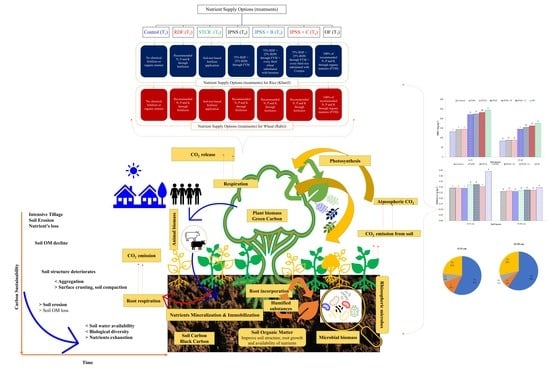Effect of Nutrient Management on Soil Carbon Quantities, Qualities, and Stock under Rice-Wheat Production System
Abstract
1. Introduction
2. Materials and Methods
2.1. Study Area and Site Characteristics
2.2. Experimental Design and Nutrient Management
2.3. Soil Carbon Pool Analysis
2.4. Data Analysis
3. Results and Discussion
3.1. Walkley and Black Carbon (WBC)
3.2. Total Organic Carbon (TOC)
3.3. Very Labile Soil Organic Carbon (VLC)
3.4. Labile Soil Organic Carbon (LC)
3.5. Less Labile Soil Organic Carbon (LLC)
3.6. Non-Labile Soil Organic Carbon (NLC)
3.7. Hot Water Extractable Carbon (HWEC)
3.8. Permanganate Oxidisable Carbon (KMnO4-C)
3.9. Microbial Biomass Carbon (MBC)
3.10. Carbon Fractions Contribution
3.11. Carbon Stock (C-Stock)
3.12. Correlation Matrix
4. Conclusions and Recommendations
Author Contributions
Funding
Institutional Review Board Statement
Data Availability Statement
Conflicts of Interest
Abbreviations
References
- Abhilash, P.C. Restoring the Unrestored: Strategies for Restoring Global Land during the UN Decade on Ecosystem Restoration (UN-DER). Land 2021, 10, 201. [Google Scholar] [CrossRef]
- Edrisi, S.A.; Abhilash, P.C. Exploring marginal and degraded lands for biomass and bioenergy production: An Indian scenario. Renew. Sustain. Energy Rev. 2016, 54, 1537–1551. [Google Scholar] [CrossRef]
- Tiefenbacher, A.; Sandén, T.; Haslmayr, H.-P.; Miloczki, J.; Wenzel, W.; Spiegel, H. Optimizing Carbon Sequestration in Croplands: A Synthesis. Agronomy 2021, 11, 882. [Google Scholar] [CrossRef]
- Lal, R. Soil management for carbon sequestration. S. Afr. J. Plant Soil 2021, 38, 231–237. [Google Scholar] [CrossRef]
- Lal, R. Soil Carbon Sequestration Impacts on Global Climate Change and Food Security. Science 2004, 304, 1623–1627. [Google Scholar] [CrossRef]
- Davidson, E.A.; Janssens, I.A. Temperature sensitivity of soil carbon decomposition and feedbacks to climate change. Nature 2006, 440, 165–173. [Google Scholar] [CrossRef]
- Paustian, K.; Lehmann, J.; Ogle, S.; Reay, D.; Robertson, G.P.; Smith, P. Climate-smart soils. Nature 2016, 532, 49–57. [Google Scholar] [CrossRef]
- Singh, M.; Sarkar, B.; Sarkar, S.; Churchman, J.; Bolan, N.; Mandal, S.; Menon, M.; Purakayastha, T.J.; Beerling, D.J. Stabilization of Soil Organic Carbon as Influenced by Clay Mineralogy. In Advances in Agronomy; Elsevier: Amsterdam, The Netherlands, 2018; Volume 148, pp. 33–84. ISBN 978-0-12-815179-2. [Google Scholar]
- Janzen, H.H. Carbon cycling in earth systems—A soil science perspective. Agric. Ecosyst. Environ. 2004, 104, 399–417. [Google Scholar] [CrossRef]
- Meena, V.S.; Mondal, T.; Pandey, B.M.; Mukherjee, A.; Yadav, R.P.; Choudhary, M.; Singh, S.; Bisht, J.K.; Pattanayak, A. Land use changes: Strategies to improve soil carbon and nitrogen storage pattern in the mid-Himalaya ecosystem, India. Geoderma 2018, 321, 69–78. [Google Scholar] [CrossRef]
- Edrisi, S.A.; Abhilash, P.C. Need of transdisciplinary research for accelerating land restoration during the UN Decade on Ecosystem Restoration. Restor. Ecol. 2021, 29, e13531. [Google Scholar] [CrossRef]
- Meena, V.S.; Ghosh, B.N.; Singh, R.J.; Bhattacharyya, R.; Sharma, N.K.; Alam, N.M.; Meena, S.K.; Mishra, P.K. Land use types and topographic position affect soil aggregation and carbon management in the mountain agro-ecosystems of the Indian Himalayas. Land Degrad. Dev. 2020, 32, 3992–4003. [Google Scholar] [CrossRef]
- Guillaume, T.; Bragazza, L.; Levasseur, C.; Libohova, Z.; Sinaj, S. Long-term soil organic carbon dynamics in temperate cropland-grassland systems. Agric. Ecosyst. Environ. 2021, 305, 107184. [Google Scholar] [CrossRef]
- Rumpel, C.; Amiraslani, F.; Chenu, C.; Garcia Cardenas, M.; Kaonga, M.; Koutika, L.-S.; Ladha, J.; Madari, B.; Shirato, Y.; Smith, P.; et al. The 4p1000 initiative: Opportunities, limitations and challenges for implementing soil organic carbon sequestration as a sustainable development strategy. Ambio 2020, 49, 350–360. [Google Scholar] [CrossRef]
- Wang, W.; Sardans, J.; Zeng, C.; Zhong, C.; Li, Y.; Peñuelas, J. Responses of soil nutrient concentrations and stoichiometry to different human land uses in a subtropical tidal wetland. Geoderma 2014, 232, 459–470. [Google Scholar] [CrossRef]
- Mattila, T.J.; Hagelberg, E.; Söderlund, S.; Joona, J. How farmers approach soil carbon sequestration? Lessons learned from 105 carbon-farming plans. Soil Tillage Res. 2022, 215, 105204. [Google Scholar] [CrossRef]
- Baveye, P.C.; Schnee, L.S.; Boivin, P.; Laba, M.; Radulovich, R. Soil Organic Matter Research and Climate Change: Merely Re-storing Carbon Versus Restoring Soil Functions. Front. Environ. Sci. 2020, 8, 1–8. [Google Scholar] [CrossRef]
- Lal, R. Restoring Soil Quality to Mitigate Soil Degradation. Sustainability 2015, 7, 5875–5895. [Google Scholar] [CrossRef]
- Wu, L.; Zhang, S.; Ma, R.; Chen, M.; Wei, W.; Ding, X. Carbon sequestration under different organic amendments in saline-alkaline soils. CATENA 2021, 196, 104882. [Google Scholar] [CrossRef]
- Choudhary, M.; Panday, S.C.; Meena, V.S.; Singh, S.; Yadav, R.P.; Mahanta, D.; Mondal, T.; Mishra, P.K.; Bisht, J.K.; Pattanayak, A. Long-term effects of organic manure and inorganic fertilization on sustainability and chemical soil quality indicators of soybean-wheat cropping system in the Indian mid-Himalayas. Agric. Ecosyst. Environ. 2018, 257, 38–46. [Google Scholar] [CrossRef]
- Wen, Y.; Liu, W.; Deng, W.; He, X.; Yu, G. Impact of agricultural fertilization practices on organo-mineral associations in four long-term field experiments: Implications for soil C sequestration. Sci. Total Environ. 2019, 651, 591–600. [Google Scholar] [CrossRef]
- Ghosh, B.N.; Meena, V.S.; Singh, R.J.; Alam, N.M.; Patra, S.; Bhattacharyya, R.; Sharma, N.K.; Dadhwal, K.S.; Mishra, P.K. Effects of fertilization on soil aggregation, carbon distribution and carbon management index of maize-wheat rotation in the north-western Indian Himalayas. Ecol. Indic. 2019, 105, 415–424. [Google Scholar] [CrossRef]
- Chen, S.; Arrouays, D.; Angers, D.A.; Martin, M.P.; Walter, C. Soil carbon stocks under different land uses and the applicability of the soil carbon saturation concept. Soil Tillage Res. 2019, 188, 53–58. [Google Scholar] [CrossRef]
- Wankhede, M.; Dakhli, R.; Manna, M.C.; Sirothia, P.; Rahman, M.M.; Ghosh, A.; Bhattacharyya, P.; Singh, M.; Jha, S.; Patra, A.K. Long-term manure application for crop yield stability and carbon sequestration in subtropical region. Soil Use Manag. 2021, 37, 264–276. [Google Scholar] [CrossRef]
- Sharma, N.K.; Singh, R.J.; Mandal, D.; Kumar, A.; Alam, N.M.; Keesstra, S. Increasing farmer’s income and reducing soil erosion using intercropping in rainfed maize-wheat rotation of Himalaya, India. Agric. Ecosyst. Environ. 2017, 247, 43–53. [Google Scholar] [CrossRef]
- Singh, R.J.; Ghosh, B.N.; Sharma, N.K.; Patra, S.; Dadhwal, K.S.; Meena, V.S.; Deshwal, J.S.; Mishra, P.K. Effect of seven years of nutrient supplementation through organic and inorganic sources on productivity, soil and water conservation, and soil fertility changes of maize-wheat rotation in north-western Indian Himalayas. Agric. Ecosyst. Environ. 2017, 249, 177–186. [Google Scholar] [CrossRef]
- Meena, S.K.; Dwivedi, B.S.; Meena, M.C.; Datta, S.P.; Singh, V.K.; Mishra, R.P.; Chakraborty, D.; Dey, A.; Meena, V.S. Long-Term Nutrient Supply Options: Strategies to Improve Soil Phosphorus Availability in the Rice-Wheat System. Sustainability 2022, 14, 8629. [Google Scholar] [CrossRef]
- Walkley, A.; Black, I.A. An examination of the Degtjareff method for determining soil organic matter, and a proposed modification of the chromic acid titration method. Soil Sci. 1934, 37, 29–38. [Google Scholar] [CrossRef]
- Jenkinson, D.S.; Powlson, D.S. The effects of biocidal treatments on metabolism in soil—V: A method for measuring soil biomass. Soil Biol. Biochem. 1976, 8, 209–213. [Google Scholar] [CrossRef]
- Tirol-Padre, A.; Ladha, J.K. Assessing the Reliability of Permanganate-Oxidizable Carbon as an Index of Soil Labile Carbon. Soil Sci. Soc. Am. J. 2004, 68, 969–978. [Google Scholar] [CrossRef]
- Gomez, K.A.; Gomez, A.A. Statistical Procedures for Agricultural Research; John Wiley and Sons: New York, NY, USA, 1984; 680p. Available online: https://pdf.usaid.gov/pdf_docs/PNAAR208.pdf (accessed on 1 September 2022).
- Manna, M.C.; Swarup, A.; Wanjari, R.H.; Mishra, B.; Shahi, D.K. Long-term fertilization, manure and liming effects on soil organic matter and crop yields. Soil Tillage Res. 2007, 94, 397–409. [Google Scholar] [CrossRef]
- von Lützow, M.; Kögel-Knabner, I.; Ludwig, B.; Matzner, E.; Flessa, H.; Ekschmitt, K.; Guggenberger, G.; Marschner, B.; Kalbitz, K. Stabilization mechanisms of organic matter in four temperate soils: Development and application of a conceptual model. J. Plant Nutr. Soil Sci. 2008, 171, 111–124. [Google Scholar] [CrossRef]
- Bhattacharyya, R.; Tuti, M.D.; Kundu, S.; Bisht, J.K.; Bhatt, J.C. Conservation Tillage Impacts on Soil Aggregation and Carbon Pools in a Sandy Clay Loam Soil of the Indian Himalayas. Soil Sci. Soc. Am. J. 2012, 76, 617–627. [Google Scholar] [CrossRef]
- Ghosh, A.; Bhattacharyya, R.; Meena, M.C.; Dwivedi, B.; Singh, G.; Agnihotri, R.; Sharma, C. Long-term fertilization effects on soil organic carbon sequestration in an Inceptisol. Soil Tillage Res. 2018, 177, 134–144. [Google Scholar] [CrossRef]
- Schiedung, M.; Tregurtha, C.S.; Beare, M.H.; Thomas, S.M.; Don, A. Deep soil flipping increases carbon stocks of New Zealand grasslands. Glob. Chang. Biol. 2019, 25, 2296–2309. [Google Scholar] [CrossRef]
- Herrero, M.; Henderson, B.; Havlík, P.; Thornton, P.K.; Conant, R.T.; Smith, P.; Wirsenius, S.; Hristov, A.N.; Gerber, P.; Gill, M.; et al. Greenhouse gas mitigation potentials in the livestock sector. Nat. Clim. Chang. 2016, 6, 452–461. [Google Scholar] [CrossRef]
- Sykes, A.J.; Macleod, M.; Eory, V.; Rees, R.M.; Payen, F.; Myrgiotis, V.; Williams, M.; Sohi, S.; Hillier, J.; Moran, D.; et al. Characterising the biophysical, economic and social impacts of soil carbon sequestration as a greenhouse gas removal technology. Glob. Chang. Biol. 2020, 26, 1085–1108. [Google Scholar] [CrossRef]
- Bol, R.; Poirier, N.; Balesdent, J.; Gleixner, G. Molecular turnover time of soil organic matter in particle-size fractions of an arable soil. Rapid Commun. Mass Spectrom. 2009, 23, 2551–2558. [Google Scholar] [CrossRef]
- Ladha, J.K.; Reddy, C.K.; Padre, A.T.; van Kessel, C. Role of Nitrogen Fertilization in Sustaining Organic Matter in Cultivated Soils. J. Environ. Qual. 2011, 40, 1756–1766. [Google Scholar] [CrossRef]
- Zhou, X.; Chen, C.; Wu, H.; Xu, Z. Dynamics of soil extractable carbon and nitrogen under different cover crop residues. J. Soils Sediments 2012, 12, 844–853. [Google Scholar] [CrossRef]
- Mclauchlan, K. The Nature and Longevity of Agricultural Impacts on Soil Carbon and Nutrients: A Review. Ecosystems 2006, 9, 1364–1382. [Google Scholar] [CrossRef]
- Peichl, M.; Thevathasan, N.V.; Gordon, A.M.; Huss, J.; Abohassan, R.A. Carbon Sequestration Potentials in Temperate Tree-Based Intercropping Systems, Southern Ontario, Canada. Agrofor. Syst. 2006, 66, 243–257. [Google Scholar] [CrossRef]
- Fichtner, A.; von Oheimb, G.; Härdtle, W.; Wilken, C.; Gutknecht, J.L.M. Effects of anthropogenic disturbances on soil microbial communities in oak forests persist for more than 100 years. Soil Biol. Biochem. 2014, 70, 79–87. [Google Scholar] [CrossRef]
- Ahn, M.-Y.; Zimmerman, A.R.; Comerford, N.B.; Sickman, J.O.; Grunwald, S. Carbon Mineralization and Labile Organic Carbon Pools in the Sandy Soils of a North Florida Watershed. Ecosystems 2009, 12, 672–685. [Google Scholar] [CrossRef]
- Filep, T.; Draskovits, E.; Szabó, J.; Koós, S.; László, P.; Szalai, Z. The dissolved organic matter as a potential soil quality indicator in arable soils of Hungary. Environ. Monit. Assess. 2015, 187, 479–490. [Google Scholar] [CrossRef]
- Bongiorno, G.; Bünemann, E.K.; Oguejiofor, C.U.; Meier, J.; Gort, G.; Comans, R.; Mäder, P.; Brussaard, L.; de Goede, R. Corrigendum to “Sensitivity of labile carbon fractions to tillage and organic matter management and their potential as comprehensive soil quality indicators across pedoclimatic conditions in Europe”. Ecol. Indic. 2019, 99, 38–50. [Google Scholar] [CrossRef]
- Meng, F.; Yang, X.; Riksen, M.; Geissen, V. Effect of different polymers of microplastics on soil organic carbon and nitrogen—A mesocosm experiment. Environ. Res. 2022, 204, 111938. [Google Scholar] [CrossRef]
- Jastrow, J.D.; Amonette, J.E.; Bailey, V.L. Mechanisms controlling soil carbon turnover and their potential application for enhancing carbon sequestration. Clim. Chang. 2007, 80, 5–23. [Google Scholar] [CrossRef]
- Bhattacharyya, R.; Prakash, V.; Kundu, S.; Srivastva, A.; Gupta, H. Soil aggregation and organic matter in a sandy clay loam soil of the Indian Himalayas under different tillage and crop regimes. Agric. Ecosyst. Environ. 2009, 132, 126–134. [Google Scholar] [CrossRef]
- Yan, M.; Korshin, G.; Wang, D.; Cai, Z. Characterization of dissolved organic matter using high-performance liquid chromatography (HPLC)–size exclusion chromatography (SEC) with a multiple wavelength absorbance detector. Chemosphere 2012, 87, 879–885. [Google Scholar] [CrossRef]
- Oelofse, M.; Markussen, B.; Knudsen, L.; Schelde, K.; Olesen, J.E.; Jensen, L.S.; Bruun, S. Do soil organic carbon levels affect potential yields and nitrogen use efficiency? An analysis of winter wheat and spring barley field trials. Eur. J. Agron. 2015, 66, 62–73. [Google Scholar] [CrossRef]
- Yang, W.; Xia, L.; Zhu, Z.; Jiang, L.; Cheng, X.; An, S. Shift in soil organic carbon and nitrogen pools in different reclaimed lands following intensive coastal reclamation on the coasts of eastern China. Sci. Rep. 2019, 9, 5921. [Google Scholar] [CrossRef] [PubMed]
- Li, Z.; Liu, M.; Wu, X.; Han, F.; Zhang, T. Effects of long-term chemical ertilization and organic amendments on dynamics of soil organic C and total N in paddy soil derived from barren land in subtropical China. Soil Till. Res. 2010, 106, 268–274. [Google Scholar] [CrossRef]
- Bhattacharyya, R.; Kundu, S.; Srivastva, A.K.; Gupta, H.S.; Prakash, V.; Bhatt, J.C. Long term fertilization effects on soil organic carbon pools in a sandy loam soil of the Indian sub-Himalayas. Plant Soil 2010, 341, 109–124. [Google Scholar] [CrossRef]
- Kusumawati, A.; Hanudin, E.; Purwanto, B.H.; Nurudin, M. Composition of organic C fractions in soils of different texture affected by sugarcane monoculture. Soil Sci. Plant Nutr. 2020, 66, 206–213. [Google Scholar] [CrossRef]
- Trivedi, A.; Bhattacharyya, R.; Biswas, D.R.; Das, S.; Das, T.K.; Mahapatra, P.; Shahi, D.K.; Sharma, C. Long-term impacts of integrated nutrient management with equivalent nutrient doses to mineral fertilization on soil organic carbon sequestration in a sub-tropical Alfisol of India. Carbon Manag. 2020, 11, 483–497. [Google Scholar] [CrossRef]
- Ghosh, B.N.; Meena, V.S.; Alam, N.M.; Dogra, P.; Bhattacharyya, R.; Sharma, N.K.; Mishra, P.K. Impact of conservation practices on soil aggregation and the carbon management index after seven years of maize–wheat cropping system in the Indian Himalayas. Agric. Ecosyst. Environ. 2016, 216, 247–257. [Google Scholar] [CrossRef]
- Liang, Q.; Chen, H.Q.; Gong, Y.S.; Fan, M.S.; Yang, H.F.; Lal, R.; Kuzyakov, Y. Effects of 15 years of manure and inorganic fertilizers on soil organic carbon fractions in a wheat-maize system in the North China Plain. Nutr. Cycl. Agroecosyst. 2012, 92, 21–33. [Google Scholar] [CrossRef]

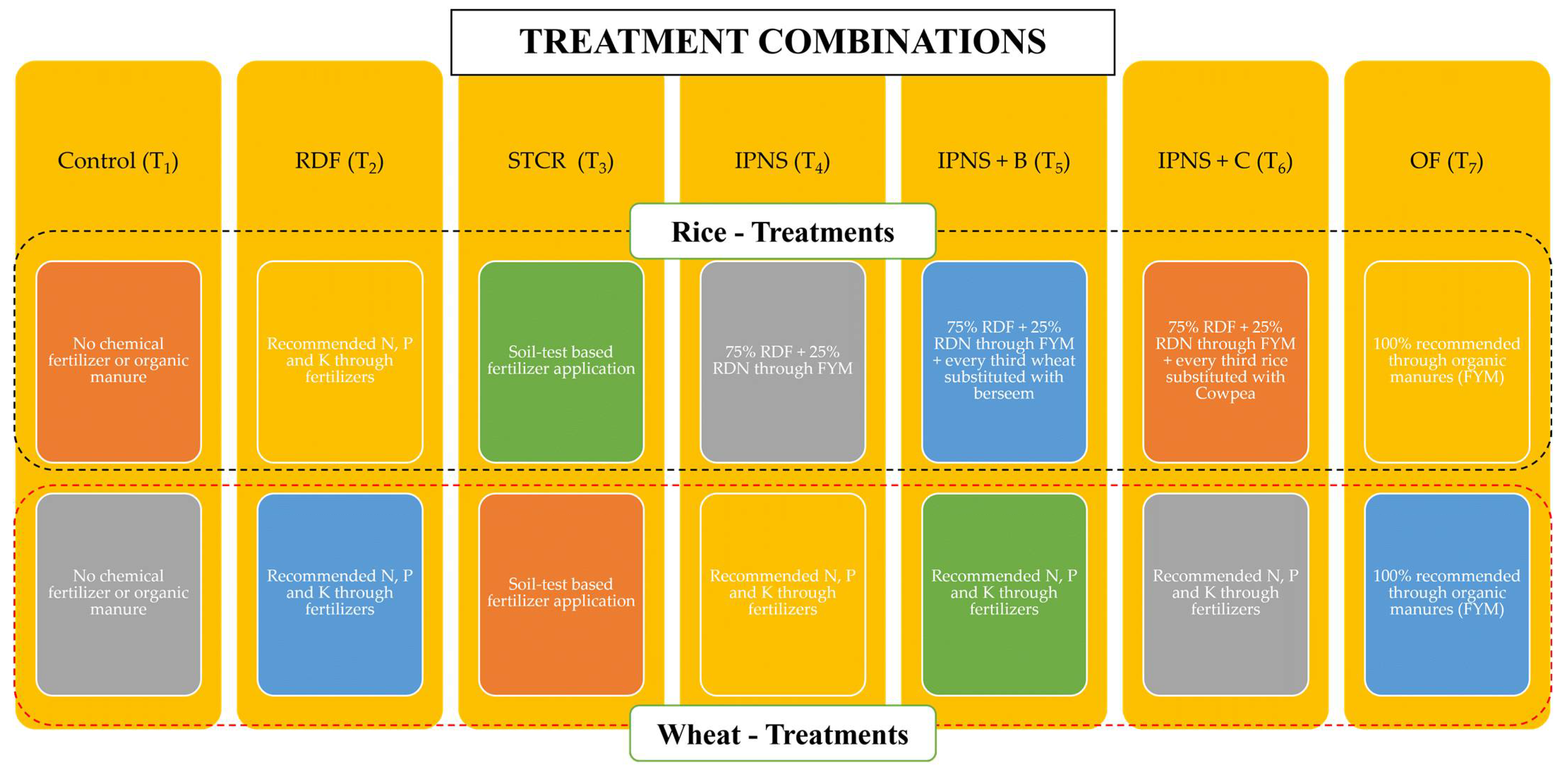
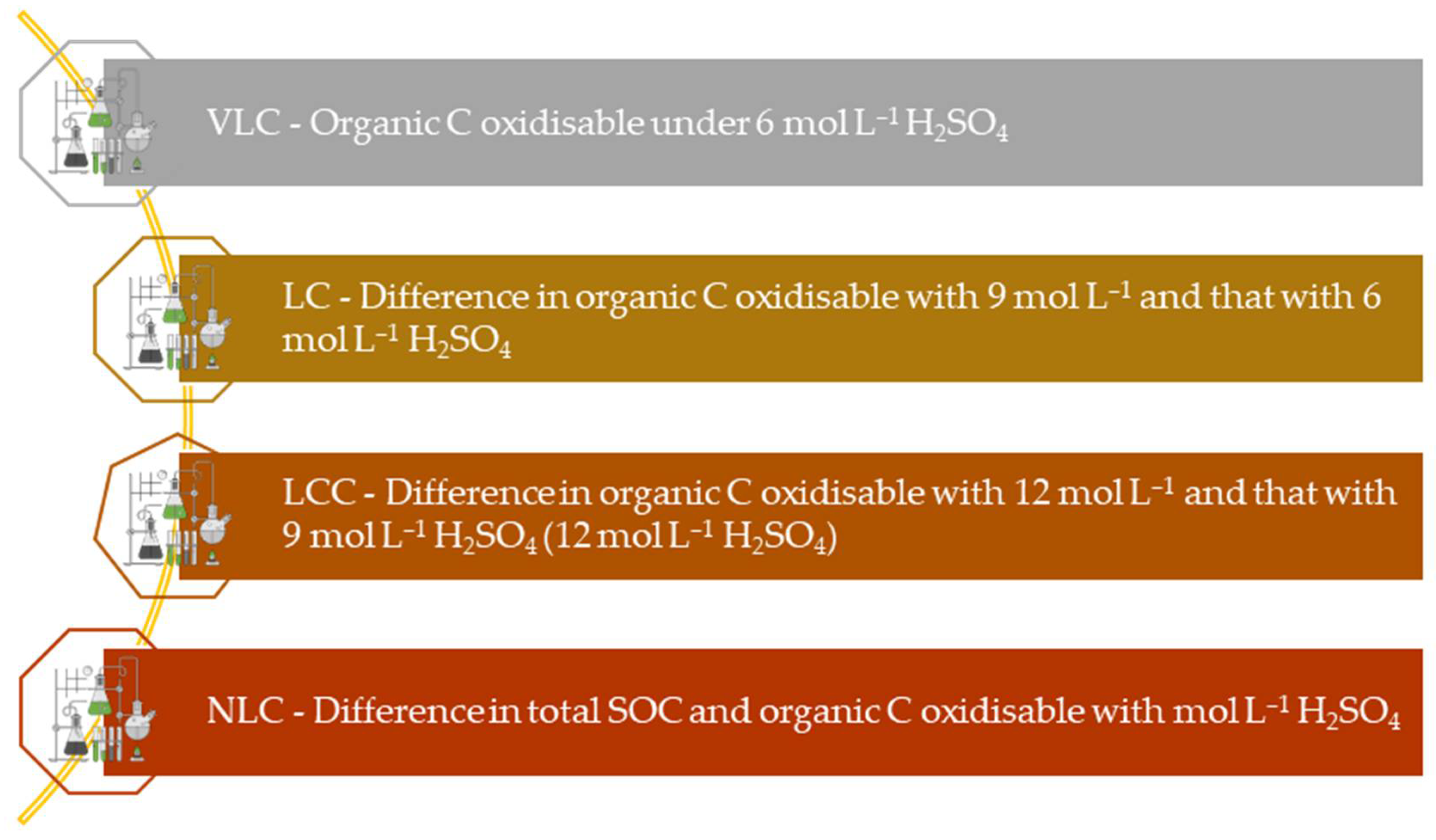
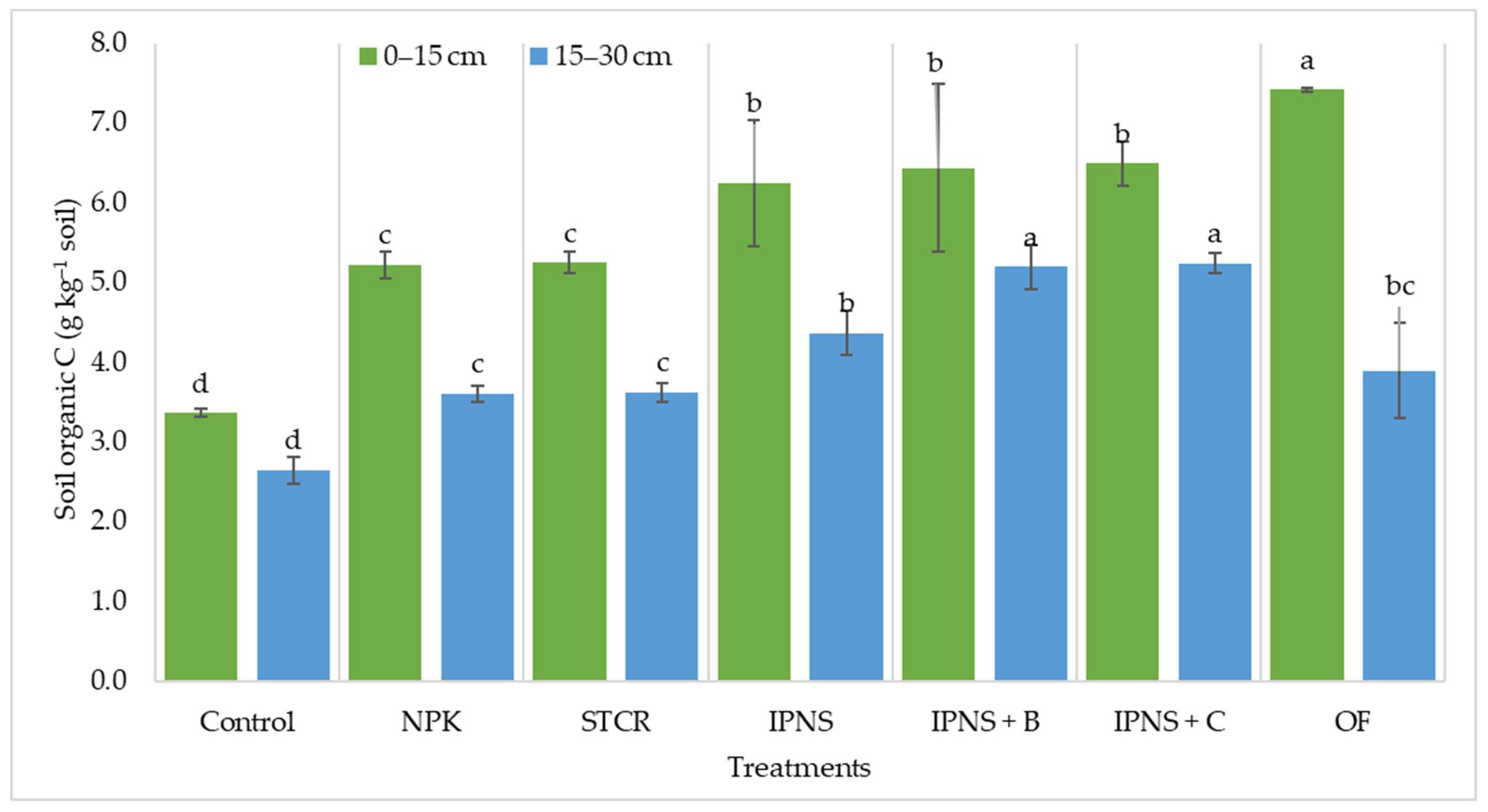
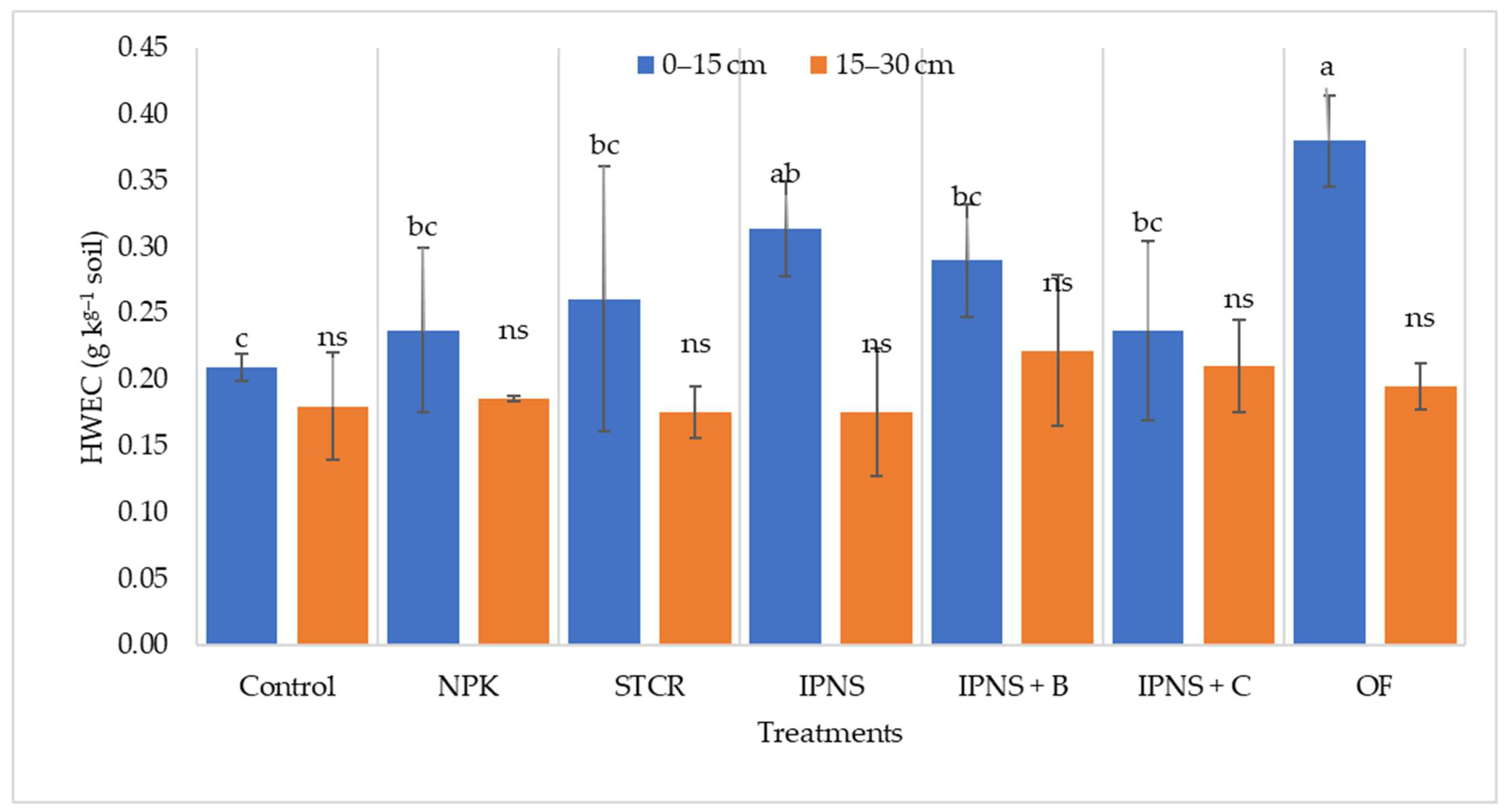
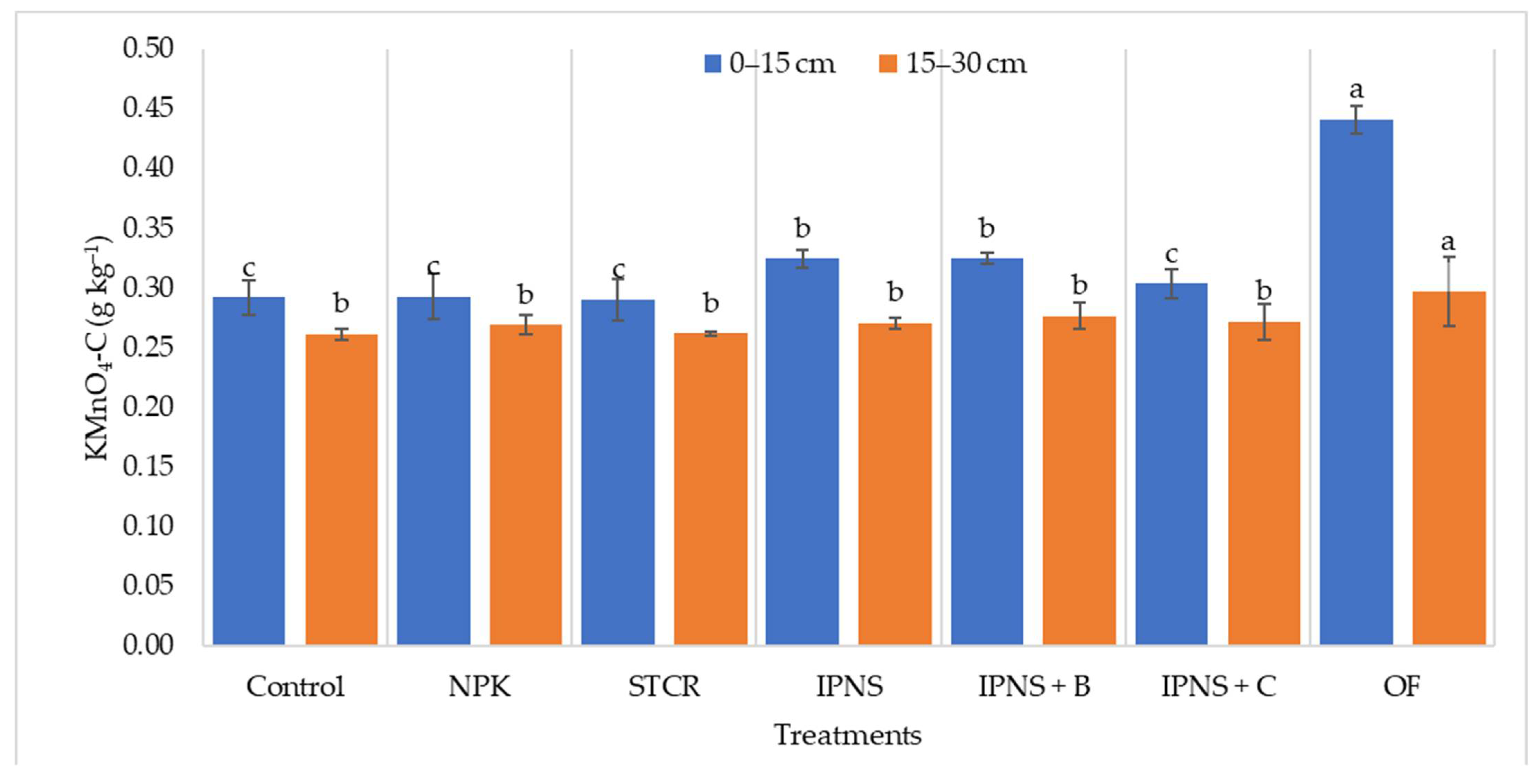
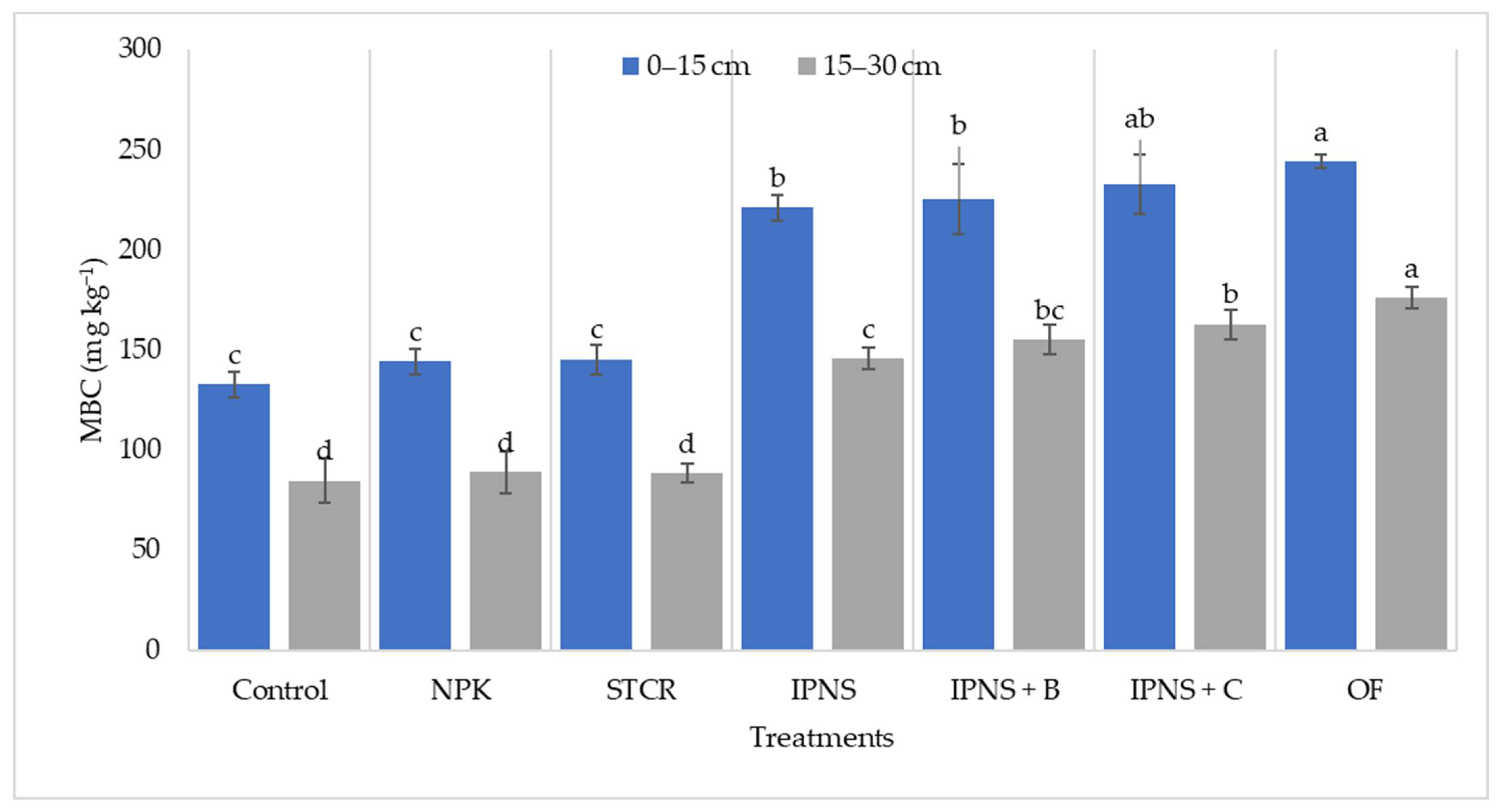


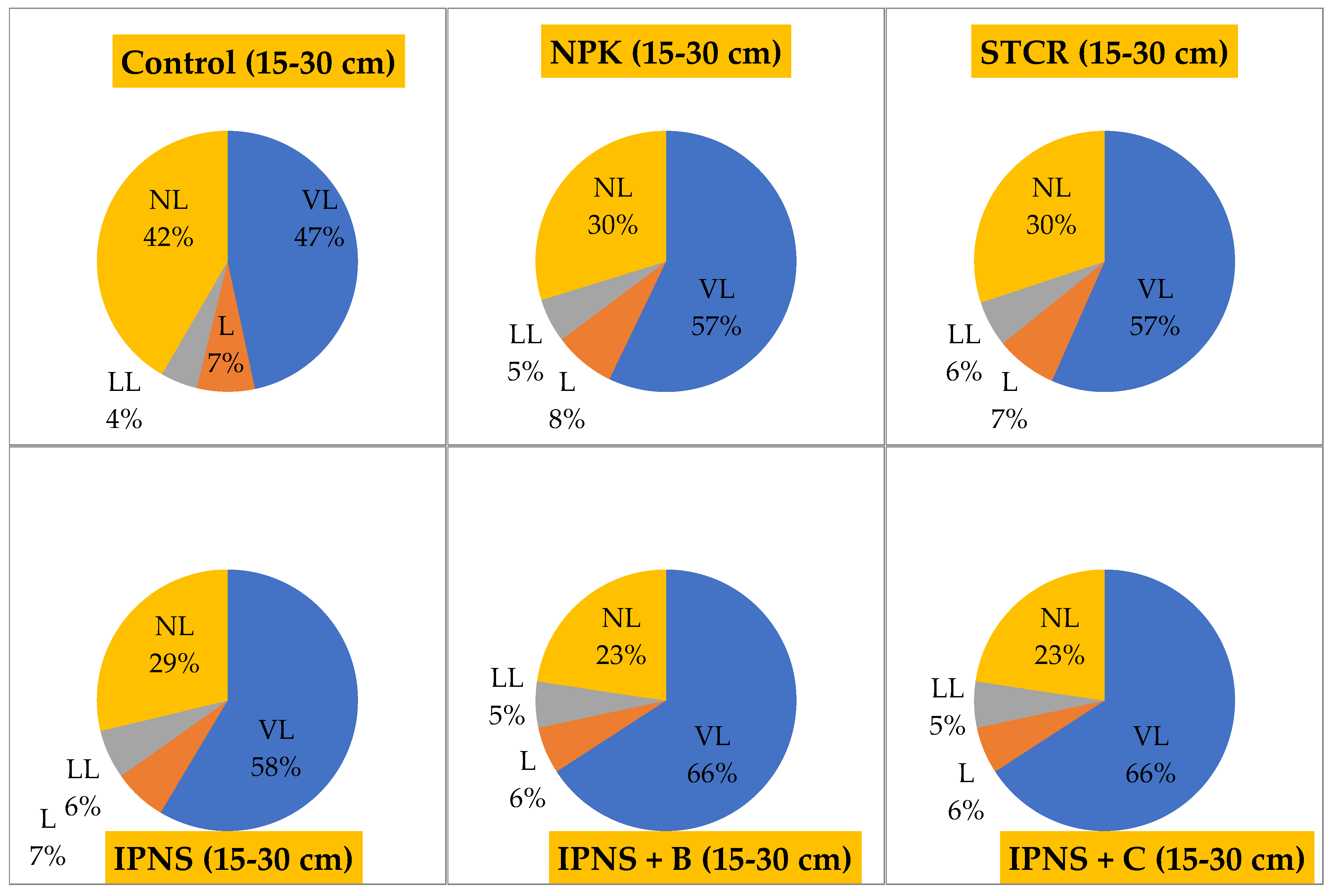

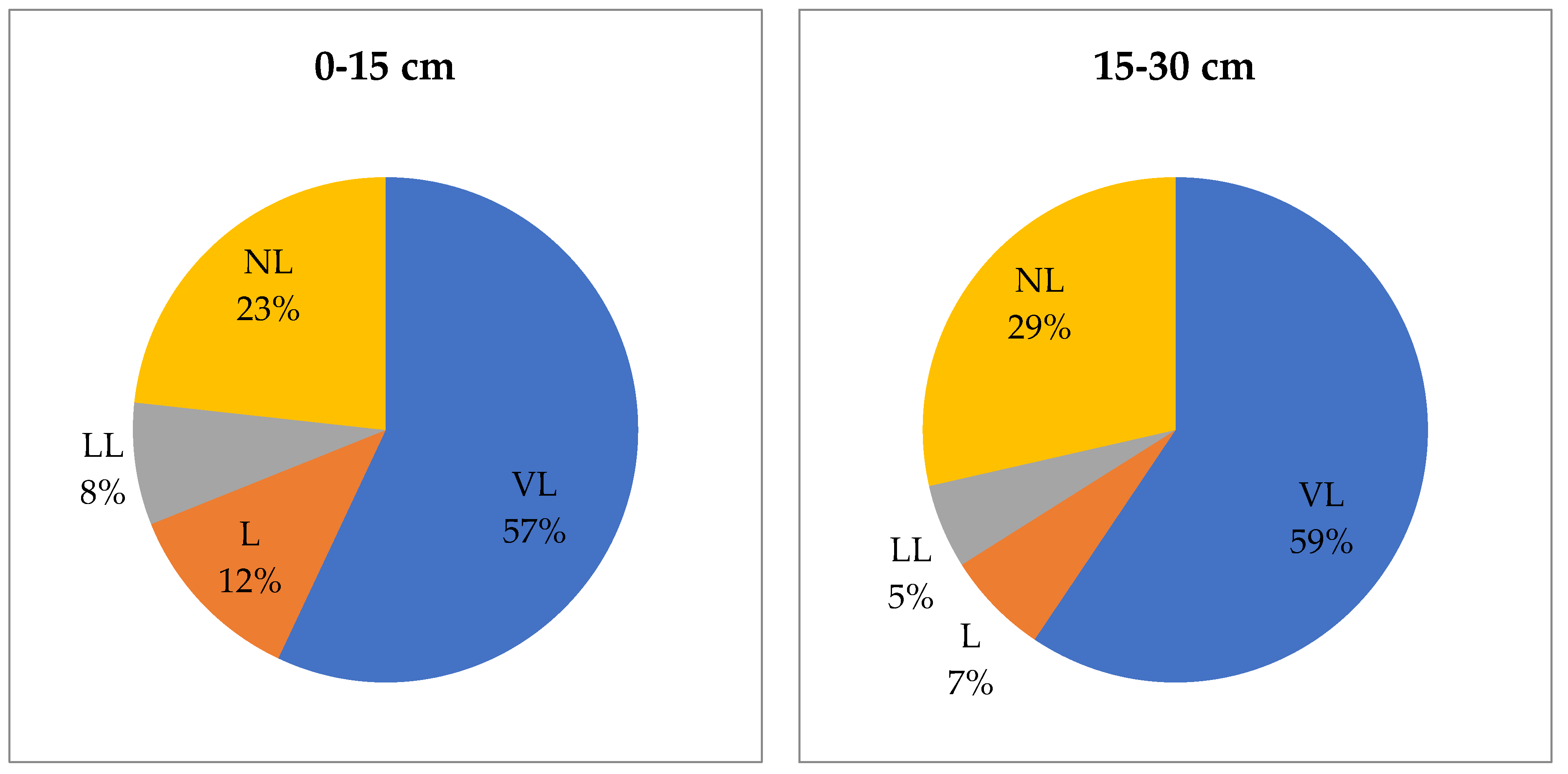
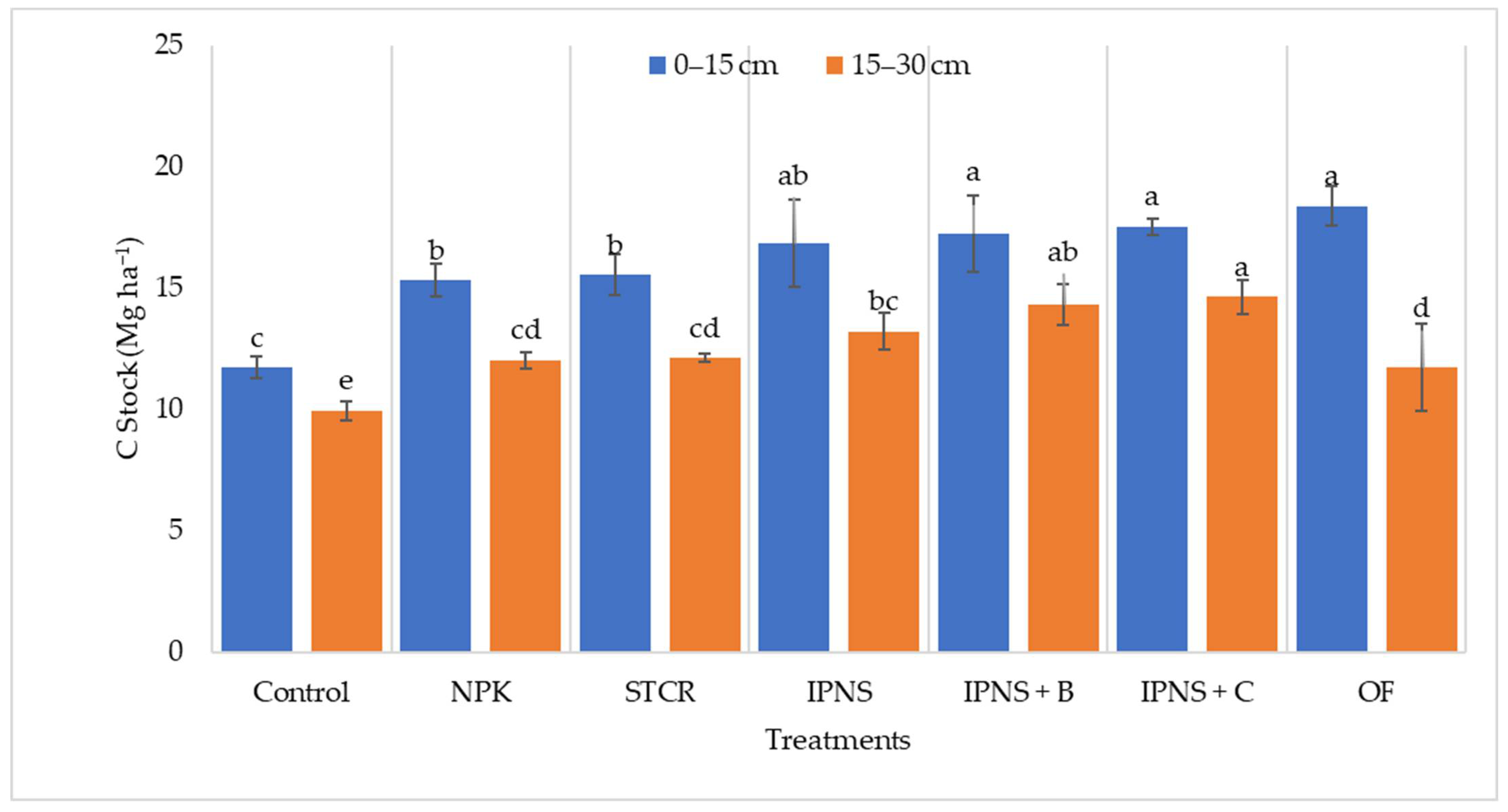
| Treatment | TOC | VLC | LC | LLC | NLC |
|---|---|---|---|---|---|
| g C kg−1 | |||||
| Control | 5.25 ± 0.20 d | 2.55 ± 0.33 d | 0.50 ± 0.06 d | 0.32 ± 0.08 c | 1.88 ± 0.21 NS |
| NPK | 6.68 ± 0.29 c | 3.99 ± 0.21 c | 0.75 ± 0.13 c | 0.48 ± 0.11 b | 1.46 ± 0.25 NS |
| STCR | 6.77 ± 0.36 c | 4.00 ± 0.17 c | 0.76 ± 0.09 c | 0.49 ± 0.09 b | 1.52 ± 0.38 NS |
| IPNS | 7.92 ± 0.84 b | 4.83 ± 0.59 b | 0.85 ± 0.09 bc | 0.57 ± 0.05 b | 1.67 ± 0.24 NS |
| IPNS + B | 8.22 ± 0.75 ab | 4.87 ± 0.27 b | 0.98 ± 0.16 b | 0.59 ± 0.11 b | 1.78 ± 0.40 NS |
| IPNS + C | 8.35 ± 0.17 ab | 4.90 ± 0.17 ab | 0.99 ± 0.13 b | 0.61 ± 0.07 b | 1.86 ± 0.14 NS |
| OF | 8.88 ± 0.39 a | 5.36 ± 0.43 a | 1.28 ± 0.16 a | 0.78 ± 0.10 a | 1.47 ± 0.41 NS |
| Treatment | TOC | VLC | LC | LLC | NLC |
|---|---|---|---|---|---|
| g C kg−1 | |||||
| Control | 4.36 ± 0.18 d | 2.13 ± 0.16 d | 0.31± 0.06 NS | 0.20 ± 0.07 NS | 1.72 ± 0.26 NS |
| NPK | 5.13 ± 0.14 c | 2.94 ± 0.17 c | 0.39 ± 0.05 NS | 0.28 ± 0.05 NS | 1.53 ± 0.15 NS |
| STCR | 5.18 ± 0.08 c | 2.94 ± 0.14 c | 0.39 ± 0.04 NS | 0.29 ± 0.05 NS | 1.56 ± 0.17 NS |
| IPNS | 6.12 ± 0.36 b | 3.58 ± 0.51 b | 0.41 ± 0.08 NS | 0.37 ± 0.03 NS | 1.76 ± 0.09 NS |
| IPNS + B | 6.73 ± 0.39 a | 4.43 ± 0.15 a | 0.39 ± 0.04 NS | 0.38 ± 0.06 NS | 1.53 ± 0.24 NS |
| IPNS + C | 6.98 ± 0.34 a | 4.44 ± 0.20 a | 0.44 ± 0.13 NS | 0.36 ± 0.15 NS | 1.74 ± 0.37 NS |
| OF | 5.68 ± 0.86 bc | 3.30 ± 0.07 bc | 0.34 ± 0.04 NS | 0.28 ± 0.08 NS | 1.78 ± 0.36 NS |
| Properties | VLC | LC | LLC | NLC | TOC | MBC |
|---|---|---|---|---|---|---|
| WBC | 0.990 ** | 0.940 ** | 0.935 ** | 0.205 NS | 0.978 ** | 0.859 * |
| VLC | 1 | 0.884 ** | 0.885 ** | 0.211 NS | 0.970 ** | 0.862 * |
| LC | 1 | 0.952 ** | 0.269 NS | 0.935 ** | 0.830 * | |
| LLC | 1 | −0.027 NS | 0.868 * | 0.678 NS | ||
| NLC | 1 | 0.403 NS | 0.668 NS | |||
| TOC | 1 | 0.945 ** |
Publisher’s Note: MDPI stays neutral with regard to jurisdictional claims in published maps and institutional affiliations. |
© 2022 by the authors. Licensee MDPI, Basel, Switzerland. This article is an open access article distributed under the terms and conditions of the Creative Commons Attribution (CC BY) license (https://creativecommons.org/licenses/by/4.0/).
Share and Cite
Meena, S.K.; Dwivedi, B.S.; Meena, M.C.; Datta, S.P.; Singh, V.K.; Mishra, R.P.; Chakraborty, D.; Dey, A.; Meena, V.S. Effect of Nutrient Management on Soil Carbon Quantities, Qualities, and Stock under Rice-Wheat Production System. Agriculture 2022, 12, 1822. https://doi.org/10.3390/agriculture12111822
Meena SK, Dwivedi BS, Meena MC, Datta SP, Singh VK, Mishra RP, Chakraborty D, Dey A, Meena VS. Effect of Nutrient Management on Soil Carbon Quantities, Qualities, and Stock under Rice-Wheat Production System. Agriculture. 2022; 12(11):1822. https://doi.org/10.3390/agriculture12111822
Chicago/Turabian StyleMeena, Sunita K., Brahma S. Dwivedi, Mahesh C. Meena, Saba P. Datta, Vinod K. Singh, Rajendra P. Mishra, Debashish Chakraborty, Abir Dey, and Vijay S. Meena. 2022. "Effect of Nutrient Management on Soil Carbon Quantities, Qualities, and Stock under Rice-Wheat Production System" Agriculture 12, no. 11: 1822. https://doi.org/10.3390/agriculture12111822
APA StyleMeena, S. K., Dwivedi, B. S., Meena, M. C., Datta, S. P., Singh, V. K., Mishra, R. P., Chakraborty, D., Dey, A., & Meena, V. S. (2022). Effect of Nutrient Management on Soil Carbon Quantities, Qualities, and Stock under Rice-Wheat Production System. Agriculture, 12(11), 1822. https://doi.org/10.3390/agriculture12111822







